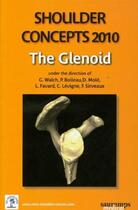Résumé:
Finding the right treatment for a young patient (< 60 years) with glenohumeral osteoarthritis is still a challenge. In case of failure of conservative therapy, surgical treatment must be considered. The indications for a surgical treatment depend not only on the radiological findings but also on... Voir plus
Finding the right treatment for a young patient (< 60 years) with glenohumeral osteoarthritis is still a challenge. In case of failure of conservative therapy, surgical treatment must be considered. The indications for a surgical treatment depend not only on the radiological findings but also on the explicit age of the patients, their occupation, activity level, duration of symptoms, comorbidities and concomitant shoulder pathology.
Arthroscopic management of glenohumeral arthritis includes capsular release, removal of loose bodies, subacromial decompression, axillary nerve neurolysis, biceps tenodesis, chondroplasty, microfracturing, and humeral osteophyte resection. This can result in pain relief, but usually does not improve shoulder motion. However, these effects are temporary and results are unpredictable.
Furthermore, these techniques do not provide a definitive solution for advanced-stage glenohumeral arthritis. Osteotomy or bone graft in case of glenoid dysplasia has yielded disappointing results as well.
Today, an unacceptable compromise in quality of life may constitute a valid indication for shoulder replacement in young patients who seek so-called «high-performance shoulders» to attain their expectations and aspirations. Initial pain relief and functional improvement are usually excellent after shoulder arthroplasty; however, these gains are short-lived in the younger population, with a dramatic decline in functional outcome and survival rate at mid- to long-term follow-up. The concerns about shoulder arthroplasty in this population are mainly due to the higher demands on the operated shoulder, the higher expectations regarding the surgical result, and the longevity of the prosthetic shoulder due to increased life expectancy.
Younger patients who receive a total shoulder arthroplasty have a higher rate of glenoid component loosening and rotator cuff tears, likely related to higher activity levels, and therefore, alternative strategies have been sought. Hemiarthroplasty has been used as an alternative, with limited benefit in the long term, likely due to unaddressed glenoid disease and a substantial rate of glenoid erosion. Biologic resurfacing of the glenoid in conjunction with hemiarthroplasty has led to disappointing results. Reverse shoulder arthroplasty is sometimes needed in younger patients in specific and difficult cases, like failed cuff repair, failed instability surgery or posttraumatic arthritis. However, long-term results of this semi-constrained prosthesis remain to be proven in the younger population.
We have invited colleagues and friends from different continents to report their surgical experience in this difficult field, and whom I thank for having accepted our invitation. We have also built a database including more than 1500 young patients with glenohumeral arthritis. The aim of the Nice multicenter study was to evaluate mid- to long-term outcomes following shoulder arthroplasty in patients younger than 60 years at the time of surgery. We have studied the results of shoulder arthroplasty in this challenging patient population according to the different etiologies, according to patients' age and have looked for complications. This study could not have been conducted without the hard work and motivation of all those who participated in it: surgeons, assistants, fellows, residents, staff, nurses, secretaries, and last but not least, our patients.
We hope that the material presented here will help surgeons to better understand and resolve the difficult problem of glenohumeral arthritis in younger patients.









